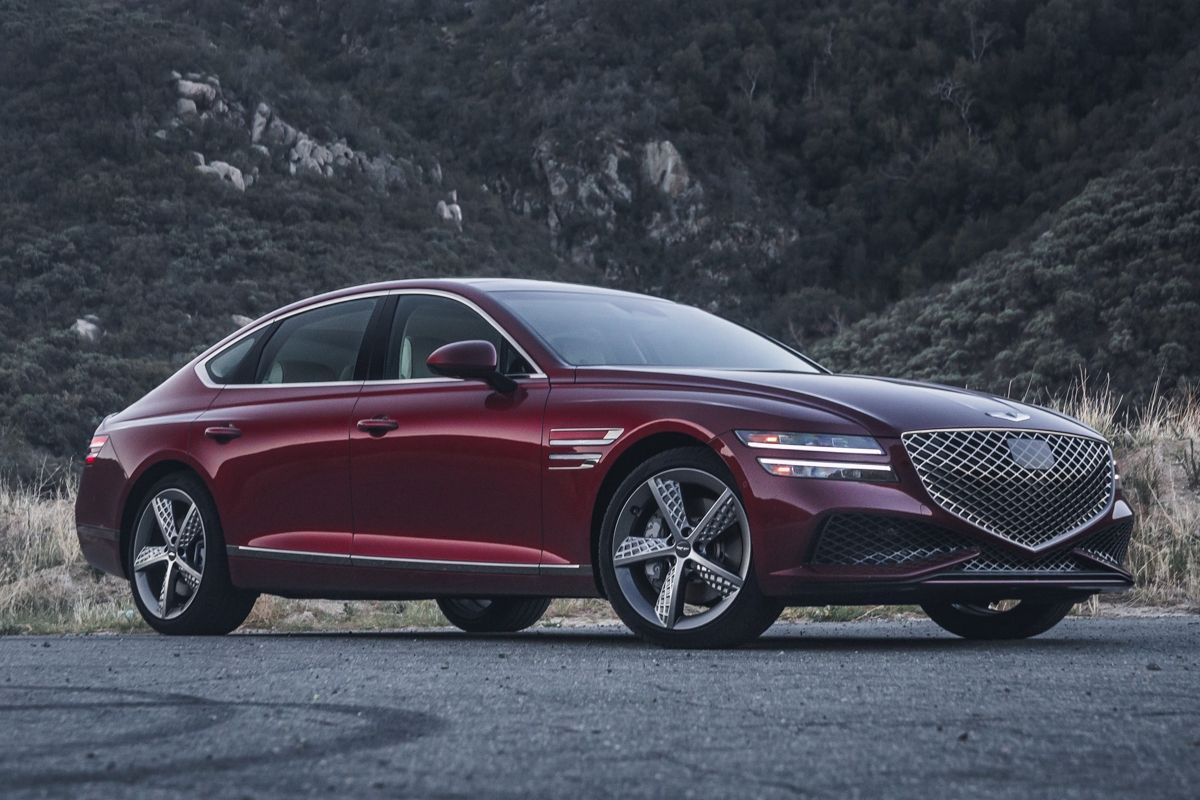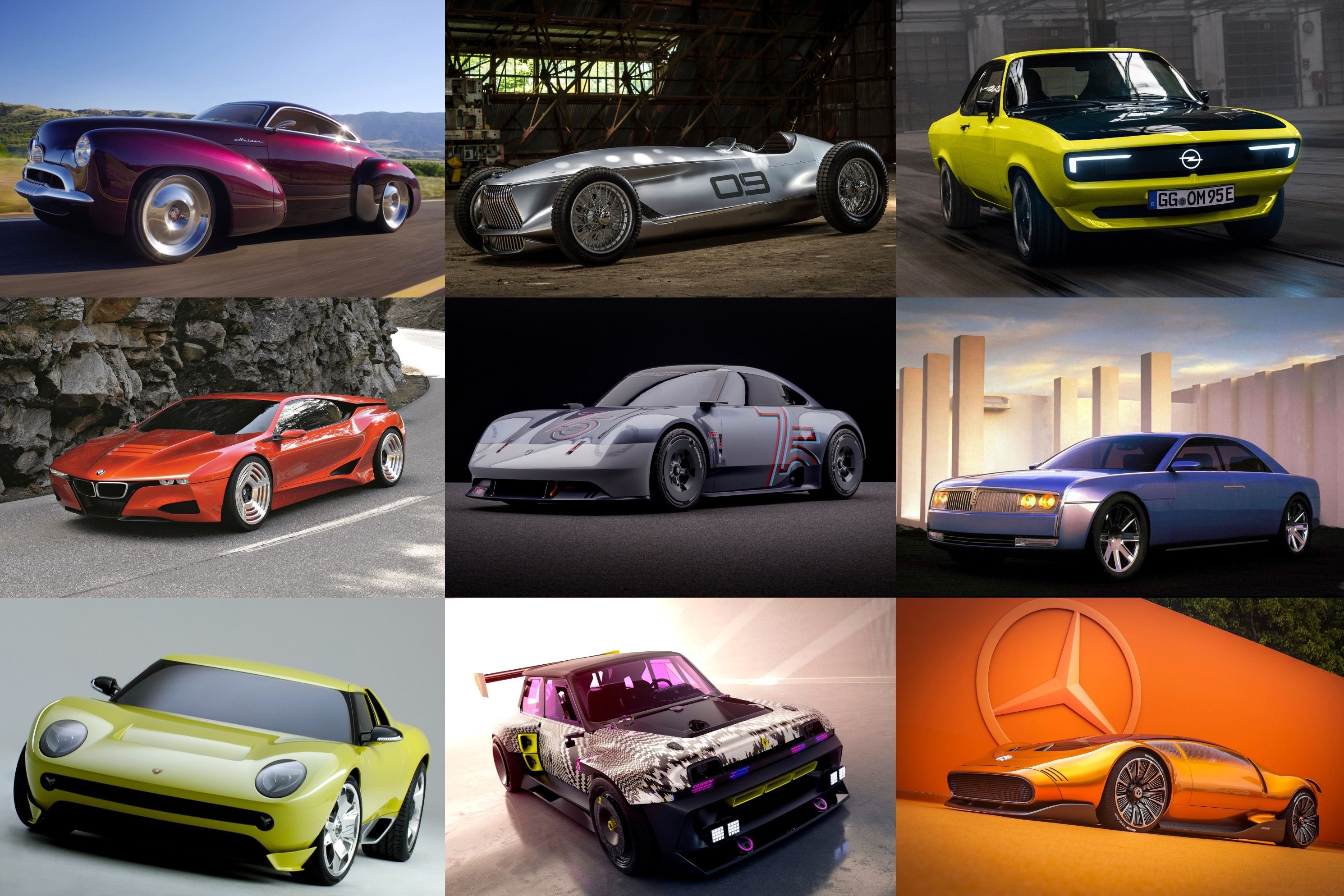
Concept cars are incredible for many reasons, yet only a tiny number ever make production as they tend to be created as design and technology demonstrations.
There's a massive chunk of brilliant design ideas that are never seen again, especially when they are retro-themed. Retro has been tried before, and, well, we were given the Chrysler PT Cruiser. And the failed modern Beetle. Luckily, some retro designs survive, including the Mini Cooper, Fiat 500e, and the beloved Ford Mustang.
Still, manufacturers leave a lot on the table at a time when manufacturing has never been easier than before, thanks to platform sharing. We went through some of the best retro concepts over the last 20-odd years to find the cars that stunned crowds but never made it to production. Here they are, in no particular order.
This list was originally published in 2018 but has been updated with relevant information from 2023.
1. Opel Manta GSe ElektroMOD
The Opel Manta concept debuted a few months before General Motors sold the brand to Stellantis. Last we heard, Stellantis will bring it back, but as a crossover. What a pity because the Manta had so much potential as a fun, lightweight runabout.
Inside the petite body, Opel fitted a small 31 kWh battery and a single motor that only produced 145 horsepower and 166 lb-ft of torque. With such a small body and battery, the Manta would have been in the same weight category as a Mazda Miata but with instant torque sent to the rear wheels through a four-speed manual gearbox. That's right, Opel started the electric vehicle manual gearbox trend way before Toyota got there.
We also loved the retro, stripped-out interior with a '70s steering wheel and elevated shifter.
2. Holden Efijy
Holden may be dead, but its contribution to the automotive world was significant. Over the decades, Holden built some of the coolest V8-powered sedans and coupes to hit Australia's roads. Before Holden became globalized, its Australian employees had some wonderfully crazy ideas, including 2005's Efijy Concept.
Inspired by the 1953 Holden FJ, built in Australia, this stunning concept was designed entirely in-house at Holden's design and engineering studio. How nuts were those Aussies?
The Efijy is based on a stretched C6 Chevrolet Corvette platform and was powered by a supercharged 6.0-liter LS2 V8 producing 644 hp and 560 lb-ft of torque. Power was sent to the rear wheels through a four-speed automatic gearbox (this was nearly 20 years ago), and the concept also boasted a fully customized exhaust system.
The interior featured electronic instrumentation, such as a multi-use display screen that could disappear into the dash. Was it too wild to produce? Kind of, yes, but a toned-down version could have been possible. Just look at the Plymouth Prowler, one of the weirdest cars ever produced by a mass manufacturer.
3. Lincoln Continental
The Lincoln Continental. Great large luxury car, but the wrong type of car for the time (blame crossovers).
When the final model was introduced in 2017, the Continental failed to set the sales charts alight. It was ultimately canned in 2020, and now Lincoln only produces a series of SUVs and crossovers.
It might have worked if Lincoln had gone more radical with the design. The recipe sure seems to be working for Genesis, which builds magnificent sedans and is not planning on stopping anytime soon. The G80 is particularly good.
Interestingly, Genesis has filed a patent for suicide doors, one of this concept's standout features. It seems the American brand dropped the ball, and the South Koreans are reaping the rewards.
4. Porsche Vision 357
The Porsche Vision 357 is a design study heavily influenced by the legendary 356. Basically, it was Porsche showing the world what the OG would like like if it was built today. Unfortunately, Porsche can't be bothered to build it.
While it has all the design characteristics of a modern electric vehicle, the 357 is actually equipped with the same powertrain as the 2023 Porsche 718 Cayman GT4 RS. The engine has been adapted to run on synthetic fuel, which may be the savior of internal combustion.
It's a masterpiece of design, blending old and new perfectly.
5. Jeep Staff Car
The Jeep Wrangler is one of a handful of cars that retains the design characteristics of its ancestor. It's also extremely retro underneath, despite some substantial updates for the 2024 model year.
Over the years, Jeep has launched several Wrangler-based concepts that were never intended for production, but one, in particular, stood out; the 2015 Wrangler Staff Car.
Based on the previous generation JK Wrangler, the Staff Car Concept was modified to look like the original Willys MG, complete with flat fenders, no doors, matte, sand-colored paint job, and even classic Firestone NDT tires. Although it has a stock drivetrain and instrument panel, just about every other part has been modified for that cool military look.
Who wouldn't want to have a side-mounted ax ready to go?
6. Infiniti Prototype 9
The new era of all-electric cars presents many opportunities, including designs, so why not have fun?
Infiniti did precisely that with the Prototype 9 Concept. This open-wheeled electric retro roadster combined ingenuity, artistry, and craftsmanship. Although it looks like a 1940s-era race car, the Prototype 9 was the first Infiniti powered by an EV powertrain, consisting of a nine kWh battery paired to a single electric motor. Total output was 148 hp and 236 lb-ft of torque. It could sprint to 62 mph in a respectable 5.5 seconds.
While there was never any real hope of Prototype 9 making production, it was at least interesting. The same can't be said of the Q50. Luckily, Infiniti seems to be on the right path, with four new products coming before 2027.
7. BMW M1 Hommage
Oh, what could have been. BMW hasn't produced a bona fide supercar since the original M1, but a few years ago, it gave us hope by introducing the M1 Hommage. It was just one of several amazing BMW concepts that never saw the light of day.
The M1 Hommage was only a design study, and some of the design elements were eventually used on the i8 hybrid. But BMW could have made it work. It's not like the Germans don't have some amazing engines to play with.
Instead, it made the XM. *cringes*
8. Lamborghini Miura
In 2006 Lamborghini introduced the Miura Concept to celebrate the 40th anniversary of the classic Miura's debut at the Geneva Motor Show in 1966.
It was a stunning car built on the savage Murcielago platform. That meant it had a 6.5-liter naturally aspirated V12 mated to a six-speed manual gearbox. At the time, Lambo's CEO, Stephan Winkelmann, said that the Italian manufacturer had no plans to put it into production because it didn't do retro.
His stint at Bugatti must have changed his mind because, upon his return to Lamborghini, he gave the go-ahead for the modern Lamborghini Countach, which isn't nearly as cool as the Miura Concept.
9. Renault 5 TURBO 3E
The car you see here will reach production in some form but toned down severely. The Renault 5 TURBO 3E was an homage to the R5 Turbo, one of the gnarliest hot hatches ever built. It weighed next to nothing and was equipped with a 160-hp turbocharged four-pot that sent the power to the rear wheels.
Renault used the same recipe for the TURBO 3E, mounting the battery packs behind the front seats for similar weight distribution. Each rear wheel was equipped with two motors, resulting in a combined power output of 375 hp and 516 lb-ft. The car weighed just 2,160 pounds, arguably making it the first of the lightweight electric hypercars.
This concept was built for drifting and possibly to drum up support for the production car. Hopefully, Alpine's take on the electric hot hatch will be closer in spirit to the Renault 5 TURBO 3E.
10. Mercedes Vision One-Eleven
Mercedes says the Vision One-Eleven is a progressive interpretation of its C 111 experimental vehicles. The C 111 was a series of mid-engined supercars built in the '70s, seemingly so Mercedes could experiment with different engines. The first units were equipped with rotary engines, while later models were oil burners.
The design is perhaps too radical for the road, but some parts of the One-Eleven are more important than others. The German brand used the One-Eleven to debut its next-generation axial-flux motors, which are three times smaller than standard electric motors used these days. One small motor produces 480 hp and 590 lb-ft of torque. Provide each wheel with a motor, and we're talking about a car with 1,920 hp and 2,360 lb-ft.
The design may not reach the road, but Merc has confirmed that these motors will be used across its range.

